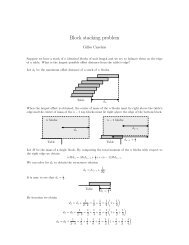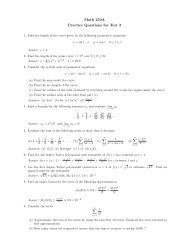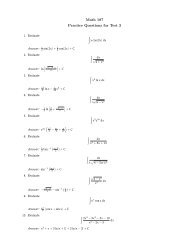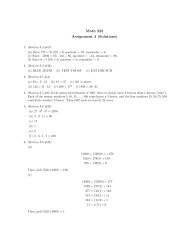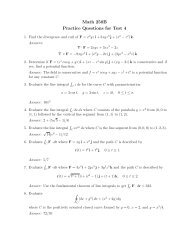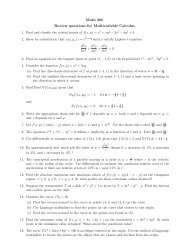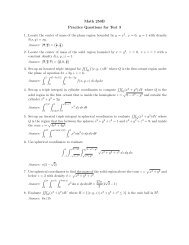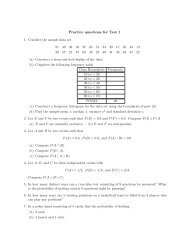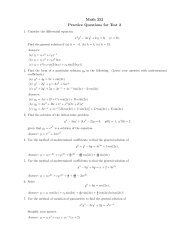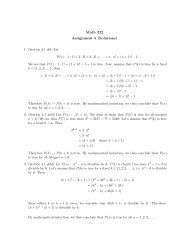Method of Undetermined Coefficients
Method of Undetermined Coefficients
Method of Undetermined Coefficients
Create successful ePaper yourself
Turn your PDF publications into a flip-book with our unique Google optimized e-Paper software.
If g(x) = g 1 (x) + g 2 (x) + · · · + g k (x), we apply the procedure separately to each g i (x) to produce a<br />
particular solution<br />
y p = y p1 + y p2 + · · · + y pk .<br />
Example. If<br />
then the basic form <strong>of</strong> y p is<br />
g(x) = x 2 + 4xe 3x + 5 cos(2x),<br />
y p = Ax<br />
} 2 +<br />
{{<br />
Bx + C<br />
}<br />
+ (Dx + E)e 3x + F cos(2x) + G sin(2x) .<br />
} {{ } } {{ }<br />
y p1<br />
y p2<br />
y p3<br />
“Bad Case”. If any <strong>of</strong> the y pi contains terms that duplicate terms in the homogeneous solution y c ,<br />
then that y pi must be multiplied by x n , where n is the smallest positive integer that eliminates the<br />
duplication.<br />
Example 1. Consider the equation<br />
y ′′ − 6y ′ + 8y = 3e 2x .<br />
Since the roots <strong>of</strong> m 2 − 6m + 8 = 0 are m = 2 and m = 4, then y c = c 1 e 2x + c 2 e 4x . Since g(x) = 3e 2x ,<br />
the basic form <strong>of</strong> y p is y p = Ae 2x . Since Ae 2x duplicates the term c 1 e 2x in y c , we have a “bad case”.<br />
We should multiply Ae 2x by x and use use the following<br />
Example 2. Consider the equation<br />
y p = Axe 2x<br />
y ′′ − 6y ′ + 9y = 5xe 3x .<br />
The only root <strong>of</strong> m 2 − 6m + 9 = 0 is m = 3. Then, y c = c 1 e 3x + c 2 xe 3x . Since g(x) = 5xe 3x , the basic<br />
form <strong>of</strong> y p is y p = (Ax + B)e 3x . Since this y p duplicates terms in y c , we have a “bad case”. Multiplying<br />
by x would still involve terms duplicated in y c . We should then multiply by x 2 and use the following.<br />
Example 3. Consider the equation<br />
y p = (Ax 3 + Bx 2 )e 3x<br />
y ′′ + 9y = 5e x + 2 sin(3x).<br />
The roots <strong>of</strong> m 2 + 9 = 0 are m = ±3i. Then, y c = c 1 cos(3x) + c 2 sin(3x). Since g(x) = g 1 (x) + g 2 (x),<br />
where g 1 (x) = 5e x and g 2 (x) = 2 sin(3x), then y p = y p1 + y p2 . The basic forms <strong>of</strong> y p1 and y p2 are<br />
y p1 = Ae x and y p2 = B cos(3x) + C sin(3x).<br />
Since y p2 duplicates y c , we have a “bad case”. We should multiply y p2 by x and use use the following .<br />
Observe that we do not multiply y p1 by x.<br />
y p = Ae x + Bx cos(3x) + Cx sin(3x)<br />
⋆ ⋆ ⋆



